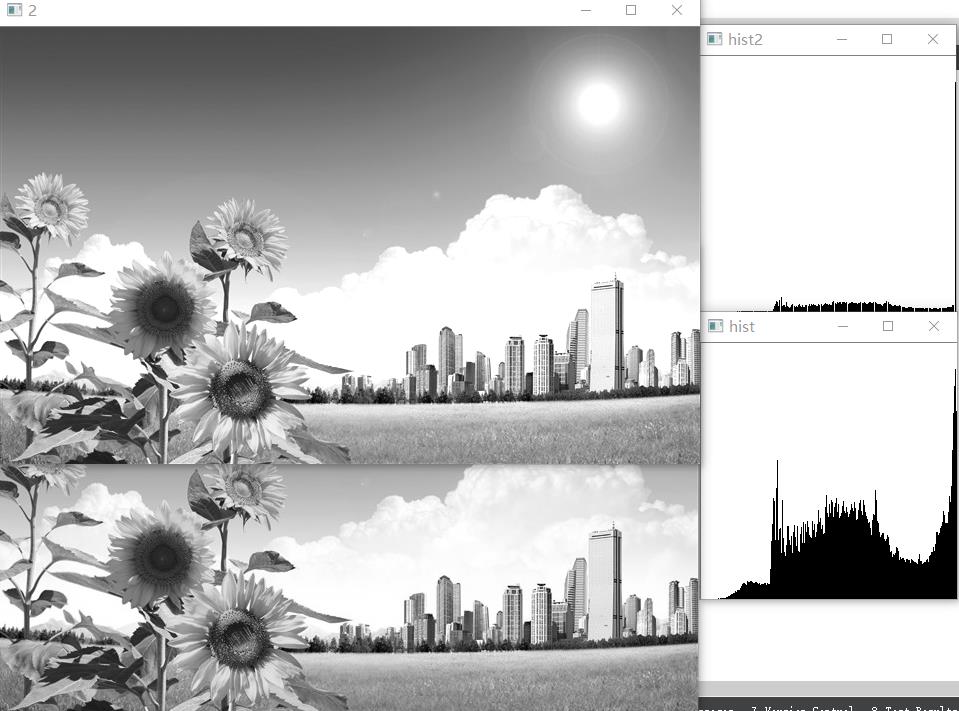OpenCV 学习笔记(颜色直方图计算 calcHist)
Posted liyuanbhu
tags:
篇首语:本文由小常识网(cha138.com)小编为大家整理,主要介绍了OpenCV 学习笔记(颜色直方图计算 calcHist)相关的知识,希望对你有一定的参考价值。
OpenCV 学习笔记(颜色直方图计算 calcHist)
最近在看一本OpenCV 的书,书名是 《OpenCV 3 Computer Vision Application Programming Cookbook (third edition)》,里面给了很多很实用的代码片段。最近这几篇学习笔记都是从这个书里摘出的代码。有些代码我又做了些小的修改。
直方图计算是个很常见的需求,OpenCV 当然也提供了相应的函数。不过OpenCV 里的函数搞的有点复杂。函数原型如下:
void calcHist( InputArrayOfArrays images,
const std::vector<int>& channels,
InputArray mask, OutputArray hist,
const std::vector<int>& histSize,
const std::vector<float>& ranges,
bool accumulate = false );
这个 calcHist 可以同时计算许多个图像的直方图,也支持多个通道图像。通常我们用不到这么复杂的功能。所以可以再进一步封装一下。下面是封装后的代码:
#ifndef HISTOGRAM_H
#define HISTOGRAM_H
#include <opencv2/imgproc/imgproc.hpp>
#include <opencv2/highgui/highgui.hpp>
class Histogram1D
{
public:
Histogram1D()
{
// Prepare arguments for 1D histogram
histSize[0] = 256;
hranges[0] = 0.0;
hranges[1] = 256.0;
ranges[0] = hranges;
channels[0] = 0; // by default, we look at channel 0
}
~Histogram1D();
// Computes the 1D histogram and returns an image of it.
cv::Mat getHistogramImage(const cv::Mat &image);
// Computes the 1D histogram.
cv::MatND getHistogram(const cv::Mat &image);
/**
* @brief stretch 拉伸图像的灰度直方图以增强图像的对比度
* @param image 输入图像,必须是8 bits 灰度图像
* @param percent 直方图两侧各舍弃百分之 percent 的点,将剩下的拉伸到 0 - 255
* @return 返回一个新的图像
*/
cv::Mat stretch(const cv::Mat &image, double percent);
cv::Mat stretch(const cv::Mat &image, double percent1, double percent2);
//直方图正规化,将图像图像最亮的地方线性拉伸到 255,最暗的地方线性拉伸到 0
cv::Mat normalize(const cv::Mat &image);
private:
int histSize[1]; // number of bins
float hranges[2]; // min and max pixel value
const float* ranges[1];
int channels[1]; // only 1 channel used here
};
class ColorHistogram
{
public:
ColorHistogram()
{
// Prepare arguments for a color histogram
histSize[0] = histSize[1] = histSize[2] = 256;
hranges[0] = 0.0; // BRG range
hranges[1] = 256.0;
ranges[0] = hranges; // all channels have the same range
ranges[1] = hranges;
ranges[2] = hranges;
channels[0] = 0; // the three channels
channels[1] = 1;
channels[2] = 2;
}
cv::MatND getHistogram(const cv::Mat &image) ;
cv::SparseMat getSparseHistogram(const cv::Mat &image) ;
private:
int histSize[3];
float hranges[2];
const float* ranges[3];
int channels[3];
};
#endif // HISTOGRAM_H
#include "histogram.h"
#include <QDebug>
#include <random>
Histogram1D::~Histogram1D()
{
}
// Computes the 1D histogram.
cv::MatND Histogram1D::getHistogram(const cv::Mat &image)
{
cv::MatND hist;
// Compute histogram
cv::calcHist(&image,
1, // histogram from 1 image only
channels, // the channel used
cv::Mat(), // no mask is used
hist, // the resulting histogram
1, // it is a 1D histogram
histSize, // number of bins
ranges // pixel value range
);
return hist;
}
cv::Mat Histogram1D::stretch(const cv::Mat &image, double percent)
{
return stretch(image, percent, percent);
}
cv::Mat Histogram1D::stretch(const cv::Mat &image, double percent1, double percent2)
{
cv::MatND hist = getHistogram(image);
int imin, imax;
if(percent1 < 0.0) percent1 = 0.0;
if(percent1 > 1.0) percent1 = 1.0;
percent1 = image.rows * image.cols * percent1;
double value = 0;
for(imin = 0; imin < histSize[0]; imin++)
{
value += hist.at<float>(imin);
if(value > percent1) break;
}
value = 0;
if(percent2 < 0.0) percent2 = 0.0;
if(percent2 > 1.0) percent2 = 1.0;
percent2 = image.rows * image.cols * percent2;
for(imax = histSize[0] - 1; imax >= 0; imax--)
{
value += hist.at<float>(imax);
if(value > percent2) break;
}
//int dim = 256;
cv::Mat lookup(1, 256, CV_8U);
for(int i = 0; i < 256; i++)
{
if(i < imin) lookup.at<uchar>(i) = 0;
else if(i > imax) lookup.at<uchar>(i) = 255;
else
{
double v = 255.0 * (i - imin) / (imax - imin);
lookup.at<uchar>(i) = static_cast<uchar>(v);
}
}
cv::Mat ret;
cv::LUT(image, lookup, ret);
return ret;
}
cv::Mat Histogram1D::normalize(const cv::Mat &image)
{
// Compute histogram first
cv::MatND hist = getHistogram(image);
int imin, imax;
for(imin = 0; imin < histSize[0]; imin++)
{
if(hist.at<float>(imin) > 0) break;
}
for(imax = histSize[0] - 1; imax >= 0; imax--)
{
if(hist.at<float>(imax) > 0) break;
}
cv::Mat lookup(1, 256, CV_8U);
for(int i = 0; i < 256; i++)
{
if(i < imin) lookup.at<uchar>(i) = 0;
else if(i > imax) lookup.at<uchar>(i) = 255;
else
{
int v = 255 * (i - imin) / (imax - imin);
lookup.at<uchar>(i) = static_cast<uchar>(v);
}
}
cv::Mat ret;
cv::LUT(image, lookup, ret);
return ret;
}
// Computes the 1D histogram and returns an image of it.
cv::Mat Histogram1D::getHistogramImage(const cv::Mat &image)
{
// Compute histogram first
cv::MatND hist = getHistogram(image);
// Get min and max bin values
double maxVal = 0;
double minVal = 0;
cv::minMaxLoc(hist, &minVal, &maxVal, 0, 0);
// Image on which to display histogram
cv::Mat histImg(histSize[0], histSize[0], CV_8U, cv::Scalar(255));
// set highest point at 90% of nbins
int hpt = static_cast<int>(0.9 * histSize[0]);
// Draw a vertical line for each bin
for( int h = 0; h < histSize[0]; h++ )
{
float binVal = hist.at<float>(h);
int intensity = static_cast<int>(binVal * hpt / maxVal);
// This function draws a line between 2 points
cv::line(histImg, cv::Point(h, histSize[0]),
cv::Point(h,histSize[0]-intensity), cv::Scalar::all(0));
}
return histImg;
}
cv::MatND ColorHistogram::getHistogram(const cv::Mat &image)
{
cv::MatND hist;
// Compute histogram
cv::calcHist(&image,
1, // histogram of 1 image only
channels, // the channel used
cv::Mat(), // no mask is used
hist, // the resulting histogram
3, // it is a 3D histogram
histSize, // number of bins
ranges // pixel value range
);
return hist;
}
cv::SparseMat ColorHistogram::getSparseHistogram(const cv::Mat &image)
{
cv::SparseMat hist(3,histSize,CV_32F);
// Compute histogram
cv::calcHist(&image,
1, // histogram of 1 image only
channels, // the channel used
cv::Mat(), // no mask is used
hist, // the resulting histogram
3, // it is a 3D histogram
histSize, // number of bins
ranges // pixel value range
);
return hist;
}
下面给个简单的例子:
cv::Mat image = cv::imread("D:\\\\向日葵.jpg");
cv::cvtColor(image, image, cv::COLOR_BGR2GRAY);
cv::imshow("origin", image);
Histogram1D hist;
cv::Mat h = hist.getHistogramImage(image);
cv::Mat his1 = hist.getHistogram(image);
cv::imshow("hist", h);
image = hist.stretch(image, 0, 0.150);
cv::imshow("2", image);
cv::Mat h2 = hist.getHistogramImage(image);
cv::Mat his2 = hist.getHistogram(image);
cv::imshow("hist2", h2);
这个例子很简单,加载一幅图像,先变成灰度图,然后计算直方图。再对图像的直方图拉伸一下,之后在重新计算直方图。输出结果如下图:

上面的例子是针对灰度图像的,对于彩色图像要用 ColorHistogram 这个类。彩色图像通常具有的颜色非常多,直接计算得到的结果会非常大。通常我们要先对颜色进行缩减操作。这个缩减操作可以用下面这个函数:
void colorReduceIO(const cv::Mat &image, // input image
cv::Mat &result, // output image
int div)
{
int nl = image.rows; // number of lines
int nc = image.cols; // number of columns
int nchannels = image.channels(); // number of channels
// allocate output image if necessary
result.create(image.rows, image.cols, image.type());
for (int j = 0; j < nl; j++)
{
// get the addresses of input and output row j
const uchar* data_in = image.ptr<uchar>(j);
uchar* data_out = result.ptr<uchar>(j);
for (int i = 0; i < nc * nchannels; i++)
{
// process each pixel ---------------------
data_out[i] = data_in[i] / div*div + div / 2;
// end of pixel processing ----------------
} // end of line
}
}
通常我们把图像数据最低2位去掉是不影响显示效果的。去掉最低的 4 位也不影响大多数的后续处理。下面给个简单的例子:
cv::Mat image = cv::imread("D:\\\\向日葵.jpg");
cv::pyrDown(image, image);
cv::Mat image4, image16, image8;
colorReduceIO(image, image4, 4);
colorReduceIO(image, image8, 8);
colorReduceIO(image, image16, 16);
cv::imshow("origin", image);
cv::imshow("image4", image4);
cv::imshow("image16", image16);
cv::imshow("image8", image8);
结果如下图:
 所以缩减一下颜色数量再做颜色直方图会减少大量内存消耗。对后续其他的处理也有帮助。
所以缩减一下颜色数量再做颜色直方图会减少大量内存消耗。对后续其他的处理也有帮助。
以上是关于OpenCV 学习笔记(颜色直方图计算 calcHist)的主要内容,如果未能解决你的问题,请参考以下文章